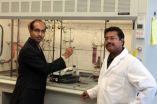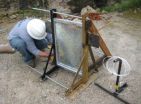Bering Sea chill yields fatter plankton, pollock diet changes
2010-12-10
(Press-News.org) Despite a 30-year warming trend, the last three years in the Bering Sea have been the coldest on record. A University of Alaska Fairbanks scientist says that the cold temperatures have helped produce larger zooplankton in the Bering Sea, which may affect the way Walleye pollock feed.
Alexei Pinchuk, research professional at the UAF Seward Marine Center, has spent the last three years gathering zooplankton samples in the Bering Sea. He and his colleagues have been looking at how changes in temperature in the Bering Sea affect resident zooplankton and, in turn, how those zooplankton shifts may affect the diet of Walleye pollock.
During colder years, like the last three, pollock tend to eat the larger zooplankton, like copepods and krill, which flourish in chillier temperatures. Pinchuk has also found that the recent cold temperatures have brought an arctic "sand-flea", the amphipod Themisto libellula, south into Bering Sea waters. Young salmon and pollock seem to prefer to eat these amphipods over other smaller zooplankton.
In warmer years, which include the record-setting high temperatures of 2001 to 2005, smaller zooplankton tend to thrive. According to Pinchuk and his colleagues, younger pollock tend to eat the smaller plankton, while larger pollock favor the larger plankton found in colder waters. This causes younger pollock to start out doing well in warmer temperatures, but as the pollock grow bigger, they may not be able to find the larger zooplankton prey they need to produce enough fat for overwintering.
"The larger pollock may then eat their smaller cousins instead," said Pinchuk.
Pinchuk conducted his research on board the U.S. Coast Guard Cutter Healy, R/V Knorr and R/V Thomas G. Thompson. He collected his zooplankton samples using multiple collecting nets.
Although the last few years have been cold, scientists predict that the warming trend in the Bering Sea will continue.
INFORMATION:
Pinchuk's findings were featured in the Nov. 4 issue of Nature magazine. His work is part of the broad Bering Sea Project, a six-year, $52 million integrated ecosystem study of the Bering Sea. The Bering Sea Project is funded by both the National Science Foundation and the North Pacific Research Board.
END
ELSE PRESS RELEASES FROM THIS DATE:
2010-12-10
New research suggests that private industry and academic science pursue different goals with different consequences, but that the two can still be complementary.
Over the past three decades, private funding and collaboration in university-based research has risen steadily. That has led to concerns about the independence and integrity of public science. However, University of Chicago sociologist James Evans finds that industry can advance academic science by shaking up its conservative nature and encouraging novel discovery.
Evans's research, released today in the American ...
2010-12-10
OAK RIDGE, Tenn., Dec. 9, 2010 -- A quicker and cheaper technique to scan molecular databases developed at the Department of Energy's Oak Ridge National Laboratory could put scientists on the fast track to developing new drug treatments.
A team led by Jerome Baudry of the University of Tennessee-ORNL Center for Molecular Biophysics adapted a widely used existing software to allow supercomputers such as ORNL's Jaguar to sift through immense molecular databases and pinpoint chemical compounds as potential drug candidates.
The research was published in the Journal of ...
2010-12-10
Used in the proper amounts, it can make teeth stronger and aid in the treatment of osteoporosis. When excessive amounts are consumed, however, it can be a killer — a carcinogen that causes bone, lung and bladder cancers. The "it" is fluoride, a common additive in most American communities' drinking water and an ingredient in the vast majority of commercially produced adult toothpastes.
Determining the level of fluoride, be it in water, consumer products or the human body, is an important and attractive challenge for scientists. To address that, a Florida State University ...
2010-12-10
A collaborative, government-led effort to guide and standardize diagnosis, treatment and management of food allergies has resulted in the release of an official set of recommendations for physicians.
The guidelines are being published online this week by the Journal of Allergy and Clinical Immunology (JACI), and available online at www.niaid.nih.gov/topics/foodallergy/clinical/Pages/default.aspx. They were developed by the National Institutes of Health and leading researchers and clinicians, professional and patient advocacy organizations, and the American Academy of ...
2010-12-10
Shootings like the one in which a gunman shot a doctor and killed a patient at The Johns Hopkins Hospital in September are "exceedingly rare," but the rate of other assaults on workers in U.S. health care settings is four times higher than other workplaces, conclude two Johns Hopkins emergency physicians after reviewing workplace violence in health settings.
The rate of assault in all private-sector industries in the United States is two per 10,000, compared to eight per 10,000 at health care workplaces, note Gabor D. Kelen, M.D., and Christina L. Catlett, M.D., in a ...
2010-12-10
Using buprenorphine instead of methadone — the current standard of care — to treat opioid-dependent pregnant women may result in healthier babies, suggests new findings from an international team led by Johns Hopkins researchers and published in the Dec. 9 issue of the New England Journal of Medicine.
Babies born to mothers taking buprenorphine instead of methadone to counter heroin and/or prescription opioid addiction were likely to need less morphine to deal with drug withdrawal symptoms, spent half as much time in the hospital after delivery and recovered from neonatal ...
2010-12-10
Johns Hopkins scientists have identified a previously unrecognized step in the activation of infection-fighting white blood cells, the main immunity troops in the body's war on bacteria, viruses and foreign proteins.
"It's as if we knew many of the generals, colonels and majors and now we have discovered a new officer that helps the troops carry out the right battle plan," says Joel Pomerantz, Ph.D., an assistant professor of Biological Chemistry in the Institute for Basic Biomedical Sciences and member of the Institute for Cell Engineering at Johns Hopkins.
The discovery, ...
2010-12-10
A myriad of inputs can indicate a body's health bombard pancreatic beta cells continuously, and these cells must consider all signals and "decide" when and how much insulin to release to maintain balance in blood sugar, for example. Reporting in Nature Chemical Biology last month, researchers at the Johns Hopkins University School of Medicine have teased out how these cells interpret incoming signals and find that three proteins relay signals similar to an electrical circuit.
"Pancreatic beta cells are influenced by hormonal, metabolic and electrical signals and something ...
2010-12-10
Using a new gene sequencing method, a team of researchers led by scientists from Johns Hopkins and the National Institutes of Health has discovered a gene that appears to cause some instances of familial amyotrophic lateral sclerosis (ALS). The finding could lead to novel ways to treat the more common form of this fatal neurodegenerative disease, which kills the vast majority of the nearly 6,000 Americans diagnosed with ALS every year.
Researchers don't know exactly what causes ALS, which destroys the motor neurons that control the movement of all the body's muscles, ...
2010-12-10
Whether in a hurricane, tornado, or bomb attack, a leading cause of injury and death is often fast-flying shards of glass. Explosions and high winds can cause windows in buildings to shatter-spewing jagged pieces of glass in every direction.
A Pentagon report on the 1996 Khobar Towers bombing in Saudi Arabia, for example, noted:
Two of the 19 deceased had injuries know to be caused by glass fragments that were severe enough to cause death even without other contributing forces. Of the remaining 17 deceased, 10 had glass injuries that were significant and which may ...
LAST 30 PRESS RELEASES:
[Press-News.org] Bering Sea chill yields fatter plankton, pollock diet changes

